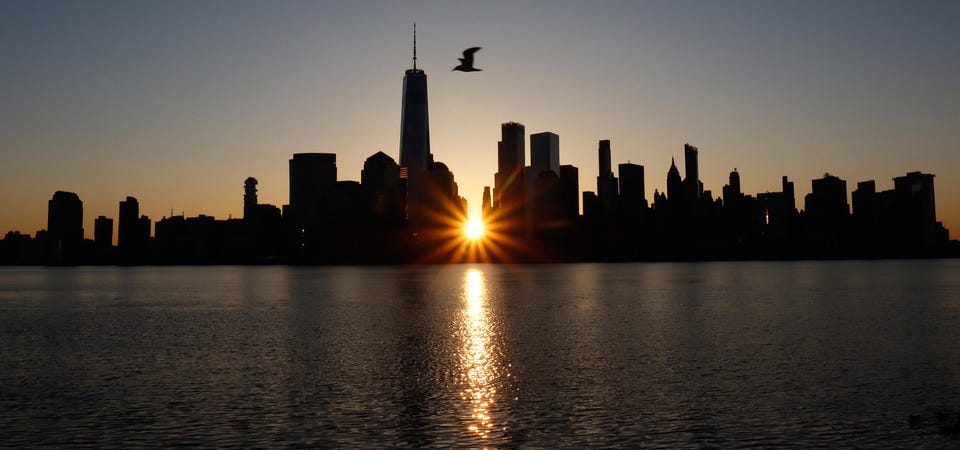Forbes Innovation Science When Is The First Day Of Spring? The Science Behind Next Week’s Equinox (And Why It’s Ideal For Stargazing) Jamie Carter Senior Contributor Opinions expressed by Forbes Contributors are their own. I inspire people to go stargazing, watch the Moon, enjoy the night sky Following Mar 16, 2023, 08:15pm EDT | Press play to listen to this article! Got it! Share to Facebook Share to Twitter Share to Linkedin The sun rises behind the skyline of lower Manhattan and One World Trade Center on the spring equinox . .
. [+] in New York City on March 20, 2021 as seen from Jersey City, New Jersey. (Photo by Gary Hershorn/Getty Images) Getty Images When is the first day of spring? You’ve heard of equinox.
It happens every year. Twice, actually. But do you understand it? Could you explain it to a child? Here’s everything you need to know about the vernal or spring equinox in 2023—when it is, what it is and why this year it’s a great time to go stargazing.
When is the spring equinox? This year the spring equinox—the beginning of astronomical spring in the northern hemisphere—will occur on Monday, March 20 at 21:25 UTC. That translates as these times in North America: 5:25 p. m.
EDT 4:25 p. m. CDT 3:25 p.
m. MDT 2:25 p. m.
PDT 1:25 p. m. AKDT 12:25 p.
m. HDT What is the spring equinox? It’s one of four markers of Earth’s annual orbit around the Sun. Like the other equinox in late September it marks a moment when the Sun is above the equator, bringing equal night and equal day to both hemispheres (equinox is Latin: equi (equal) and nox (night).
The spring equinox is when the Sun crosses the celestial equator going north, marking the transition from winter to spring in the northern hemisphere and summer to fall in the southern hemisphere. MORE FOR YOU The ‘Backsies’ Billionaire: Texan Builds Second Fortune From Wreckage Of Real Estate Empire He’d Sold Today’s ‘Heardle’ Answer And Clues For Friday, March 17 Utah Lifts Hurdle To Nurse Practitioners As 27th State To Do So The other two markers are the solstices in late June and late December, which mark the days with the longest period of daylight and longest period of darkness, respectively. During Earth’s annual orbit around the Sun, different parts of the planet get different amounts of .
. . [+] sunlight—except at the equinoxes.
getty Why do equinoxes occur? Equinoxes and solstices mark the start and end of seasons. Seasons are the direct result of our planet’s tilted axis, which changes the amount and intensity of sunlight bestowed on each hemisphere. Summer in the northern hemisphere—marked by June’s solstice—is when that half of the planet is tilted towards the Sun.
The days are longer and more sunlight reaches it. Winter is the opposite. Equinoxes are when the planet is side-on to the Sun—when the tilt of the Earth’s axis is not tilted towards or away from the Sun, which sends equal amounts of daylight and darkness to all parts of our planet.
Why is this equinox a great time to go stargazing? The very next day after the spring equinox, at 17:23 UTC, a New Moon occurs. Since a New Moon is roughly between the Earth and the Sun it is utterly invisible and its light never features it the night sky. It thus makes the night as dark as possible.
It makes a massive difference if you’re trying to find faint star clusters and constellations. As the weeks draw on after equinox the days get longer than the nights—culminating in solstice, the longest day of the year—making stargazing ever more difficult, particularly for those in northern latitudes, where is never truly gets dark in June. However, equinox itself is this year an excellent time to go stargazing because the night skies will be as dark as they ever get.
Standing Stones at Avebury, England, at sunrise on the Vernal (Spring) Equinox. The purpose of the . .
. [+] ancient obelisks remains an enigma getty How to see the equinox The Sun being directly over the equator isn’t much to see, is it? The best way to “see” an equinox or a solstice is to watch at sunrise or sunset. Only an equinox does the Sun rises due east and sets due west, which over the centuries has meant something to many ancient cultures.
As well as simply watching the Sun rise and set with the cardinal points, you could also travel to an ancient place to see the various alignments. Those places include, but are not limited to: Stonehenge and Avebury, England Newgrange, Ireland Chichen Itza, Mexico Machu Picchu, Peru Temple of Karnak, Egypt During Earth’s annual orbit around the Sun, different parts of the planet get different amounts of sunlight—except at the equinoxes. Humans have known about this for thousands of years and celebrated the changing of the seasons.
How will you mark the equal day, equal night? Wishing you clear skies and wide eyes. Follow me on Twitter or LinkedIn . Check out my website or some of my other work here .
Jamie Carter Editorial Standards Print Reprints & Permissions.
From: forbes
URL: https://www.forbes.com/sites/jamiecartereurope/2023/03/16/when-is-the-first-day-of-spring-the-science-behind-next-weeks-equinox-and-why-its-ideal-for-stargazing/



